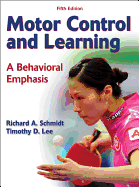
- Browse Category
Subjects
 We Begin at the EndLearn More
We Begin at the EndLearn More - Choice Picks
- Top 100 Free Books
- Blog
- Recently Added
- Submit your eBook
password reset instructions

Significantly updated with current research, new learning features, and more references, the fifth edition of "Motor Control" "and Learning: A Behavioral Approach" expertly combines text, figures, and practical examples to explain this complex topic in a clear and comprehensive manner. This outstanding introduction to the field focuses on motor behavior that can be observed directly as well as the many factors that affect the quality of these performances and the ease with which they can be learned. Additionally, the text examines some of the neurological and biomechanical processes that create complex movement behaviors, reflecting the convergence toward a shared understanding of complex movement behaviors across the fields of motor behavior and motor learning, motor control, and biomechanics.
"Motor Control and Learning, Fifth Edition," frames the important issues, theories, people, and research from the field in a reader-friendly way, giving students a clear introduction to the most current information available. Schmidt and Lee, respected researchers and authors, continue to refresh this classic and comprehensive text through the following features:
-More than 280 new references and approximately 50 pages of new content
-Expanded information on attention, human motor performance, and the learning process
-New research highlight boxes, which present issues relevant to the chapter's topic in a reader-friendly way
-Historical highlight boxes that present the historical connection to certain concepts and principles of motor behavior
-New end-of-chapter study tools, including a summary, student assignments, Web resources, and notes to help students grasp important concepts, prepare for exams, and explore online activities
-A new image bank for professors that provides access to all the images in the text for use in handouts and PowerPoint presentations
Authors Schmidt and Lee expertly present the complex topic of motor control and learning in a precise manner that students can easily understand. New and updated diagrams offer visual explanations, and practical examples illustrate concepts in motor control and learning and provide concrete suggestions for application. In addition, sidebars throughout the text provide more detailed treatment of specific research to ensure comprehension. The fifth edition features a logical progression wherein later chapters build on concepts presented in earlier chapters, resulting in a consistent framework of ideas about motor skills.
"Motor Control and Learning "begins with an introduction to research and fundamental concepts important to understanding motor behavior. In the second part of the text, readers will learn about motor control, including contributions from the sensory and central nervous systems; principles related to speed and accuracy; factors involved in movement control and coordination; and factors that determine skill differences between people and among groups of people. The final portion of the text covers skill acquisition, examining special methodological problems for studying motor learning, various theoretical treatments of motor learning, and factors associated with the retention and transfer of skills.
"Motor Control and Learning: A Behavioral Approach "presents an up-to-date review of the state of knowledge in movement control and learning, including the most recent information from several rapidly developing subfields. This edition of the text offers both practitioners and students a perspective of motor skills that serves as a basis for contributions to new and existing applications and the facilitation of new research. Less
- Publication date
- ISBN
- August 22, 2020
- 9780736079617





.jpg)


















.jpg)

